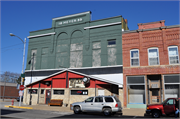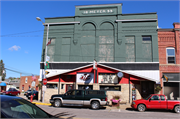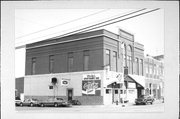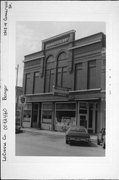| Additional Information: | This 2-story Romanesque Revival building was constructed in 1899 to serve as commercial space on the first story and an opera house on the second story. It is rectangular in plan with painted brick walls and a flat roof with a rectangular parapet at the center of the front (south) elevation. The building shares a party wall on its east side while the west elevation serves as a secondary facade. The storefront along the front (south) façade is clad in stone veneer and board and batten siding with a low-pitched gabled awning roof spanning the width of the façade (the storefront cladding and the loss of the shop windows occurred between 1977 and 1991). Two recessed entrances are located at opposite ends of the façade with small, single-pane windows located at irregular intervals. The second story of the front (south) façade consists of a center bay of window and transom openings that have been boarded over; these central window openings are capped by round arches (originally containing multi-pane glazing, these were infilled with brick between 1977 and 1991). This central bay is further accentuated by a rectangular parapet that rises above the main roofline and features brick corbelling along its cornice and additional corbelling at the base of vertical bands of brickwork that extend down along each side to frame the center window pair. Inside the parapet, a panel reads “18 / MEYER / 99.” Two singly-placed rectangular window and transom openings are located on each side of the center bay at the second story. With the exception of the easternmost transom (which contains a downsized, single-pane window), all of these window and transom openings have been boarded over. The wall above the outer bays is ornamented with horizontal bands of brick dentils, above which projects a simple stone cornice. The brick bands and cornice wrap around the west side of the building as this elevation serves as a secondary façade fronting on 16th Avenue North. The west elevation has been clad in stucco at the first story with stone veneer mimicking a raised stone foundation. A single doorway is located in the west elevation; this is accessed via wooden stoop with stairs on its north and south sides. The door and stoop are both of relatively recent construction. A small, rectangular, single-pane window is located north of the door and serves as the only window at the first story of the west elevation. The second story contains four singly-placed rectangular window and transom openings; with the exception of two transom openings that contain downsized single-pane windows, all window and transom openings have been boarded over.
This 2-story Romanesque Revival building was constructed in 1899 to serve as commercial space on the first story and an opera house on the second story. It is rectangular in plan with painted brick walls and a flat roof with a rectangular parapet at the center of the front (south) elevation. The building shares a party wall on its east side while the west elevation serves as a secondary facade. The storefront along the front (south) façade is clad in stone veneer and board and batten siding with a low-pitched gabled awning roof spanning the width of the façade (the storefront cladding and the loss of the shop windows occurred between 1977 and 1991). Two recessed entrances are located at opposite ends of the façade with small, single-pane windows located at irregular intervals. The second story of the front (south) façade consists of a center bay of window and transom openings that have been boarded over; these central window openings are capped by round arches (originally containing multi-pane glazing, these were infilled with brick between 1977 and 1991). This central bay is further accentuated by a rectangular parapet that rises above the main roofline and features brick corbelling along its cornice and additional corbelling at the base of vertical bands of brickwork that extend down along each side to frame the center window pair. Inside the parapet, a panel reads “18 / MEYER / 99.” Two singly-placed rectangular window and transom openings are located on each side of the center bay at the second story. With the exception of the easternmost transom (which contains a downsized, single-pane window), all of these window and transom openings have been boarded over. The wall above the outer bays is ornamented with horizontal bands of brick dentils, above which projects a simple stone cornice. The brick bands and cornice wrap around the west side of the building as this elevation serves as a secondary façade fronting on 16th Avenue North. The west elevation has been clad in stucco at the first story with stone veneer mimicking a raised stone foundation. A single doorway is located in the west elevation; this is accessed via wooden stoop with stairs on its north and south sides. The door and stoop are both of relatively recent construction. A small, rectangular, single-pane window is located north of the door and serves as the only window at the first story of the west elevation. The second story contains four singly-placed rectangular window and transom openings; with the exception of two transom openings that contain downsized single-pane windows, all window and transom openings have been boarded over. The building retains a moderate degree of integrity.
Until the October 1899 fire, this site was occupied by a double store building with a hall on the second floor. Known as the Schumaker block, this earlier building (constructed by George Schumaker in 1893) was destroyed in the Commercial Street fire in 1899. The same year, William G. Meyer constructed the existing building. Known both as the Bangor Opera House and Majestic Hall, the building contained an open performance hall at its second story with the first story divided between a Hussa Brewery saloon on the west and a pharmacy on the east. The pharmacy continued in operation under various owners until 1979. Similarly, the tavern changed ownership numerous times through the present day, but its function as a tavern remained. In 1979, the tavern (then Sportsman’s Bar owned by John Langrehr, Jr. and Glen Hoff) was enlarged, eliminating the division between the former pharmacy and the tavern.
In its capacity as a performance hall, the building hosted a wide range of entertainments including traveling musical groups, vaudeville companies, and square dances as well as community events including high school plays and graduation ceremonies, local musical society dances, lectures, meetings of community groups and organizations, and sales pitches by local businesses. The names of many local and traveling stage performers and musicians are etched on the interior walls of the opera house. Beginning in the 1910s, the building became known as the Majestic Theater and served as Bangor’s first movie theater, beginning with the presentation of silent films and continuing through the advent of sound films. The building continued to be known as Majestic Hall through at least 1939. By the 1940s, the opera house had “largely faded from the public scene,” although it saw service as a roller rink in later years. |
|---|




